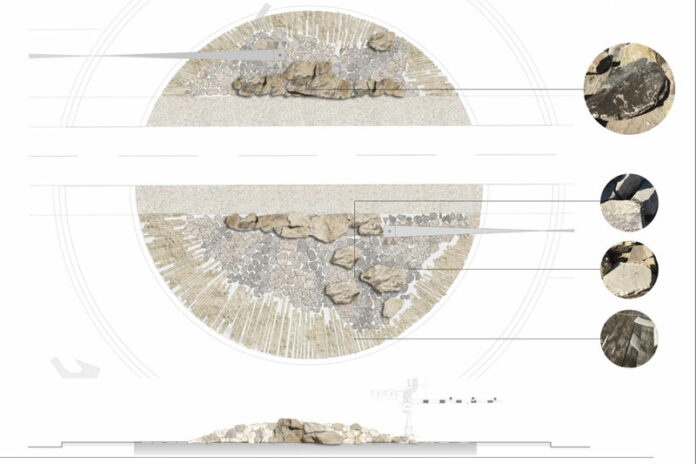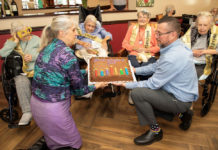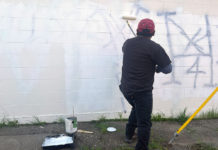
Features local stone and interactive LED lights
At their Jan. 6 meeting, the Windsor Town Council praised and approved an art installation to be integrated into the Windsor Road and Windsor River Road roundabout project. Mayor Dominic Foppoli recused himself from the discussion as has part ownership of a building with in 500 feet of the proposed art installation.
The installation had previously been designed and approved by Windsor’s Public Arts Advisory Commission, in collaboration with WRT, LLC landscape architects and consulting engineering firm of GHD, Inc.
Jacob Tobias from WRT was on hand to show the council members the final two designs and get their approval and preference.
Some of the design constraints are due to the requirements of the SMART train, which will be travelling thought the middle of the roundabout and art installation. According to the board packet, “the inclusion of a vertical, solid element is considered to be a safety feature, alerting vehicles that they are entering a roundabout and not a four-way intersection. SMART requires that any vertical element be kept 10 feet clear of the railroad tracks, and that the ground surface on either side of the tracks be clear to allow for track maintenance. Also, because the entire central roundabout area is within SMART rights-of-way, additional constraints include full track visibility, low maintenance requirements, and no surface irrigation conduits.”
Tobias though focused on the design inspirations for the design.
“We were encouraged to look at two main design inspirations. One is geology which ties to the current conditions of region but also natural history and how everything is built upon geology: agriculture depends on the geology under it, history is dependent on the richness of geology for abundant food sources,” he said. “And then, we looked at bringing cycles in. We looked at the calendar on the town’s history timeline, we went back to the Native Americans who lived here and how they considered time and seasonal change.”
That focus on geology led Tobias to make a factual discovery. “Did you know there are more types of riok here than in all of France,” he asked. “It creates terroir for wines, but it was recommended not to dwell on wine, that there is a deeper history here,” he said. “We were encouraged to bring in something dynamic that can tell a story. It was very important that we balance abstraction with meaning and have this thing have a meaning people would understand.”
The final designs incorporate local stone and interactive LED lights. One, the preferred option designated option two, had vertical slices of cut stone, while option one has more natural/uncut stones. Option two was the preference of both the art commission and the council, but cutting stone is expensive so ensuring the project could stay in budget could potentially switch the choice to option one. Both designs create a three dimensional aspect so can see from all angles.
“There will be these organic walls on either side of the railroad track, with a natural flow of stones, and at night these programmable LED lights,” Tobias said. “The lights and strips can be programmed to do anything, but the idea is to reflect annual cycles and seasons.
“We don’t want to distract drivers, and some LED displays are dynamic and quick moving, so this might change slowly the over course of entire year, for instance you might notice in winter the lights are purple and in summer they are orange,” he continued. “Another idea is to have the linear lights on the perimeter on a yearly cycle and the interior lights on a monthly cycle. It can be about cosmic movement of the moon and stars and bring that down into earth. We are focusing on using exclusively Sonoma County stone and talking about the story of that geology combining earth and cosmos. The linear pieces of stone (in option two) is adding to radial feeling. It does need to fit into the project budget, and there are plenty of ways to make this happen. But we could go back to the other concept if the cut, linear pieces are too pricy.”
The estimated cost of the art feature is estimated to be between $120,000 to $150,000, but these costs are already included in the total construction cost for the roundabout project. In fact, according to the board packet, construction of the art feature is a non-reimbursable part of the project grant funding and therefore will be paid for using local funds that have been budgeted for the roundabout project.
Questions from council members centered mainly on wear and tear and maintenance costs. Though all three remaining council members voted in favor of the piece, with a preference for option two based on cost, Councilmember Sam Salmon did feel the need to point out the challenges of public art.
“It’s lovely thing, (but) I have my doubts everyone will embrace it. We’ll have to stand fast. Art is particular. It’s a unique part of society and not everyone is involved in art,” he said.







